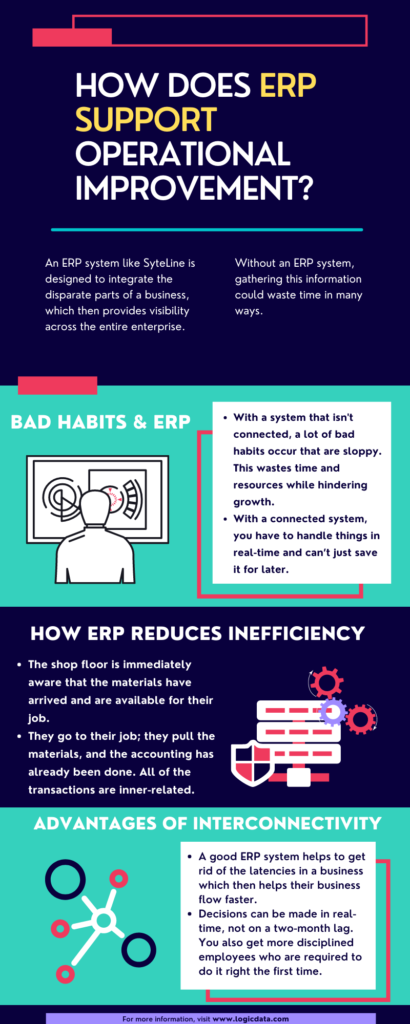

An ERP system like SyteLine is designed to integrate the disparate parts of a business, which then provides visibility across the entire enterprise. This leads to changes in processes and workflow, some subtle, some not so much, that can set the business up for expansion as well as positively affect the bottom line in a big way. This blog explores how ERP can set your enterprise up for growth while saving you money.
First let’s look at what the interconnectivity of an ERP system looks like in a production scenario. With an ERP, someone sitting in production can look and see just what the backlog of customer orders is. He can then take quick action to correct whatever he finds.
Without an ERP system, gathering this information could waste time in many ways. It might involve calling someone else (thus stopping their production flow) or walking to a different location in the plant to gather the information or even sending someone to get the information for you which now involves an entirely new person.
With an ERP system, someone over in order entry can look at his computer and see what the backlog in production is right from his desk. He can instantly answer the question, “If I take this order now, how long is it going to take to produce it?”. He then knows what he can tell the customer and his information will be much more accurate. We have now saved quite a bit of time for several employees. Spread this across the entire enterprise and your savings in labor cost alone can be very significant. Since labor cost is 20% to 35% of manufacturing costs, this can create quite an impact financially.
But what about a growth advantage? How might that work?
With ERP you get this interconnectivity which is in truth a two edged sword. You’ve got a connected system and Oh, you’ve got a connected system!
With a system that isn’t connected a lot of bad habits occur that are sloppy and easy, that end up wasting time and resources while hindering growth. With a connected system, you have to handle things in real-time and can’t just save it for later. This standardizes processes and saves time.
For example, someone at the receiving dock in a disconnected system does the following. They get a shipment. Open the box. They count and compare the number of the products in the box to the packing slip, and they throw the packing slip in their in-box. Then they put the product on the shelf.
Someone comes along several hours later, takes that product off the shelf and puts it into jobs on the floor. A day or two later the receiving guy gets back to that packing slip, makes some notes on it and takes it with his other packing slips over to accounting.
By this time all the inventory has been consumed, maybe even shipped out the door. Accounting a week later is now looking through these packing slips and says, “Whoa, you say you received 15 of these? We only ordered 12.” Now accounting is chasing discrepancies after the fact. But it did make the receiving man’s job much easier. He didn’t have to do A, then B, then C, then D rigidly. He could do A, then Q, then R, then P then Z, then B while putting off critical actions till later, at which point all the data had changed.
The receiving man’s sloppy “system” made accounting’s job harder. Because now they’re trying to track that inventory. They’re having to ask, “What job did it go into?” and “What was the cost of that job?”
When you have an ERP system in place and in use, instead of that hodgepodge, the whole flow changes. Now when the receiving clerk gets the shipment, he turns to his computer terminal and queries, “What’s the PO I am receiving this on?” He finds out It’s PO 37 and he enters the information that he has just received 15 of the items ordered.
As soon as he enters the information a warning message pops up because there were only 12 purchased on the PO. He now has to stop and double check this because there is a discrepancy. To sort it out he has to call purchasing and ask, “Hey Joe, I’ve got this 15 where 12 were ordered. What do you want me to do with this?”
Joe in purchasing says, “Go ahead and receive the 15 and I’ll change the PO.” which he then does.
So now the information is in the computer that 15 came in and accounting is immediately aware that the materials have arrived.
The shop floor is also immediately aware that the materials have arrived and are available for their job. They go to their job; they pull the materials, and the accounting has already been done. All of the transactions are inner-related. There’s no longer a disconnect between the departments.
But in all of that you’ll notice that the guy in the receiving dock had to stop. He couldn’t just throw something on a shelf, move on and come back to fix errors or address them later. He was required to do that in real time.
So, oft times you see the guys on the front lines resist these systems because it puts discipline and process in where they didn’t have discipline and process. But the guys in the back end, the guys in the accounting and management teams are going, “Oh my gosh, wonderful. I can actually click a button and see what arrived today. I can click a button and see what shipped today.” Whereas in their old system they’d have to wait until the end of the month or maybe 3 weeks after for someone to put all these reports together from the dissimilar systems.
So, they get an enormous advantage of interconnectivity, of elimination of lag of data. Data moves much more quickly through these systems and is more available in near real-time to these people who need it. It is much more accurate because it is demanding accuracy at input, not a month later at audit.
This is where the big advantages are. A good ERP system helps to get rid of the latencies in a business which then helps their business flows faster. Decisions can be made in real-time, not on a two month lag. You also get more disciplined employees who are required to do it right the first time. The employees now have to really do the job properly and not put things off till later. And although the receiving clerk might feel it added time, in the long run it saved time – lots of it. He didn’t have to field queries from accounting or purchasing; accounting didn’t have to chase things down or query him or purchasing and the business processes actually flowed much more smoothly. In addition, much of the double work (and its attendant labor cost) is eliminated thus saving time and money.
As Henry Ford said, “From time waste there can be no salvage. It is the easiest of all waste and the hardest to correct because it does not litter the floor.”
Now you have an enterprise where the processes and procedures are standardized, so when you start running at higher volume and higher speed, earlier bad habits do not bring things to a grinding halt. New personnel can be brought on and trained in the system more easily and expansion is facilitated. This is how a good ERP system like CloudSuite Industrial can set you up for future growth and with your production floor control.
Contact us today for more information on how we can help.

As with cost, implementation time is also dependent on the same factors mentioned above. LogicData offers multiple implementation methodologies that can be adapted to your specific needs and resource availability. Considering a very basic implementation of just the core functionality of SyteLine, and employing a LogicData managed implementation approach, time to value can be achieved in as little as 3-4 months. A full implementation of all core SyteLine functionality utilizing a standard implementation approach, and assuming full client resource availability, can generally be completed in 6 to 8 months. To determine the best implementation methodology and timeline estimate for your specific situation, please contact us.
The cost of software and implementation will vary based on many factors such as user count, functionality requirements, deployment, implementation methodology, customization, data conversion, integration, and internal resources. However, for a basic configuration of SyteLine annual subscription pricing can begin at approximately $18,000 annually for a minimum of 10 users or a one-time cost of $20,000 plus annual maintenance for a minimum of 5 users in an on-premise deployment. A primarily self-directed implementation of such a basic configuration, although not recommended, can likely be achieved for approximately $30,000. LogicData recommends our standard “train-the-trainer” implementation approach which is estimated to start at roughly $65,000 for a basic implementation. For further information on pricing specific to your needs, please contact us.
Leave a Reply